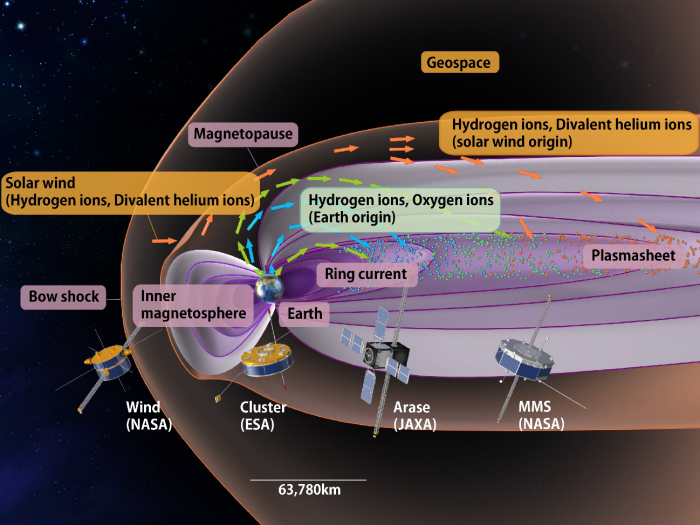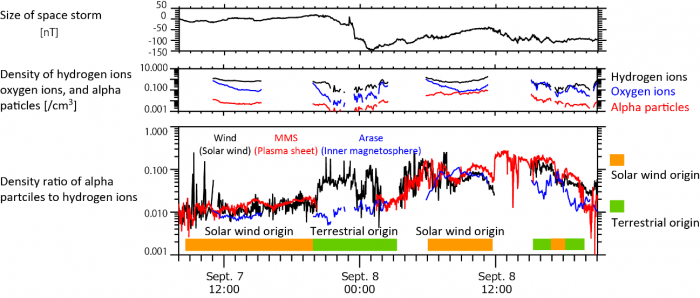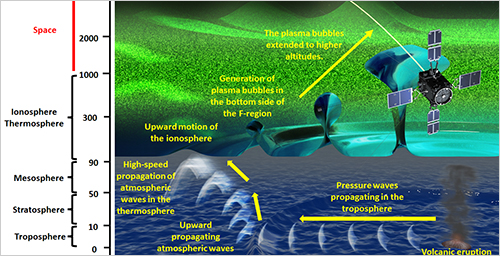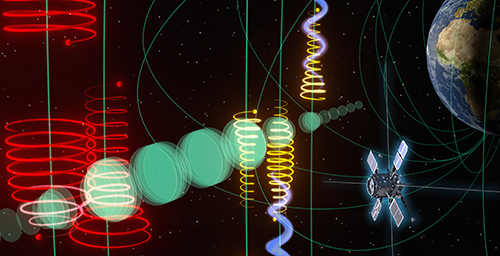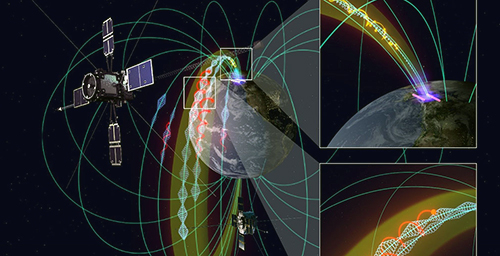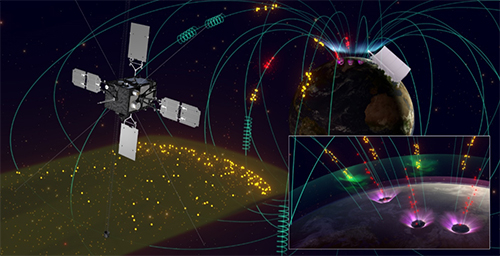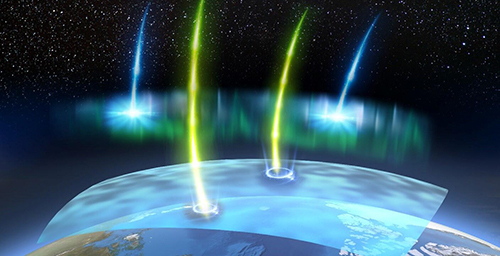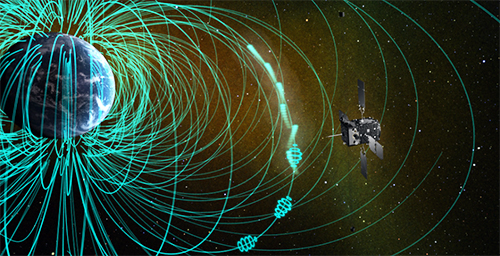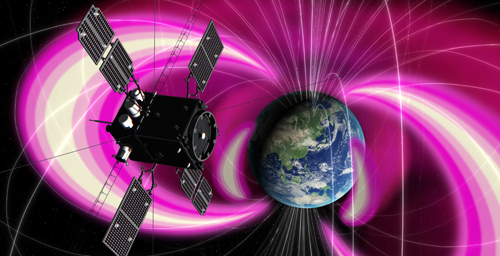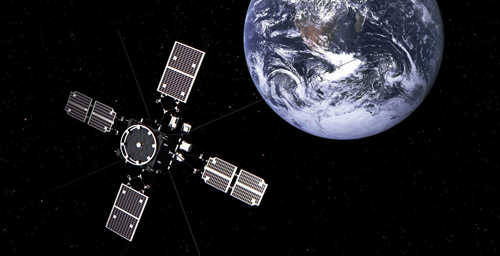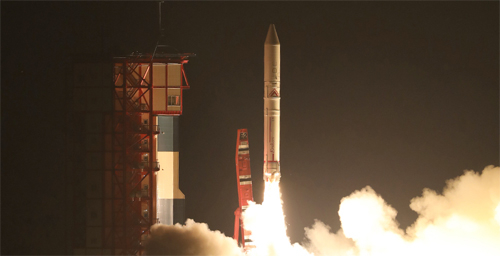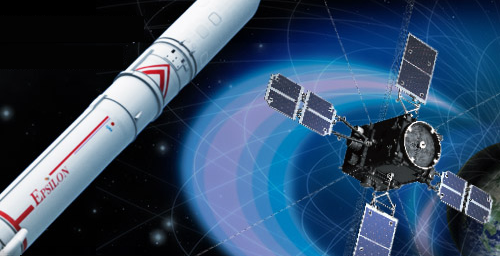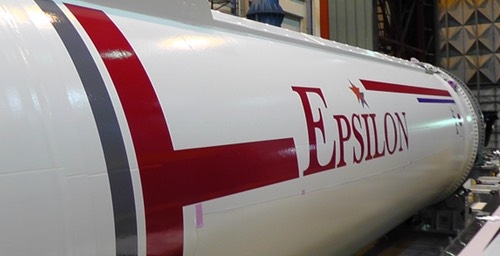~ Observations reveal that the origin of plasma entering geospace switches from the solar wind to the ionosphere as space storms progress ~
The region of outer space around the Earth is known as "geospace". In geospace, charged particles (plasma) such as ions and electrons exist, albeit in small quantities. When the quantity of ions and electrons significantly increases, geospace enters a state called a "space storm". This is accompanied by the appearance of intensely active auroras that are triggered by the increase of ions and electrons, and strong currents flow in the ionosphere at an altitude at about 100 km. Particularly strong space storms can disrupt daily life due to satellite malfunction, decreased positional accuracy, and even power outages on the ground. Understanding space storms is therefore important for the safe use of space, and is also actively studied as part of space weather research.
Space storms have been thought to arise and develop when plasma from the solar wind enters the Earth's magnetic field (magnetosphere). There is a second source of plasma that exists in the Earth's upper atmosphere (ionosphere), and hydrogen and oxygen ions are known to leak into space. However, because it is difficult to distinguish between the plasma originating from the solar wind, and the plasma originating from the Earth, the influence of the plasma from the Earth on space storms has not previously been known.
To investigate these two sources, this study examined alpha particles (divalent helium ions) contained in the solar wind plasma. Alpha particles are present in the solar wind, but not in terrestrial plasma. By simultaneously measuring the ratio of the number (density) of hydrogen ions and alpha particles in the solar wind and geospace, it is possible to distinguish between plasma originating from the solar wind and that originating from the Earth.
From September 7 to 10, 2017, a space storm occurred that was observed with JAXA's scientific satellite "Arase" that is exploring geospace, NASA's scientific satellite "MMS" (Magnetospheric Multiscale) and the solar wind observer "Wind", and ESA's (European Space Agency) scientific satellite "Cluster". The storm could therefore be analysed using a combination of data from scientific satellites from Japan, the US and Europe. The solar wind was measured by the Wind satellite, geospace was observed by MMS at an altitude of around 40,000km to 80,000km, and observed by Arase at an altitude below 40,000km, and the densities of hydrogen ions, oxygen ions, and alpha particles were compared. Within these regions, the inner region of the magnetosphere below an altitude of 40,000 km is thought to be important for the development of space storms. The observations by Arase were therefore key to understanding this phenomenon (Figure 1).
Figure 1: Observations of the solar wind and geospace by the combination of satellites from Japan, the USA and Europe. The results revealed that the plasma in the inner magnetosphere when a space storm develops is mainly composed of plasma originating from the Earth, rather than those from the solar wind. (© ERG science team)
The results from these observations are shown in Figure 2. The top panel shows the evolution of the space storm, where it can be seen that the space storm developed significantly around September 8. The bottom panel shows the ratio (density ratio) of hydrogen ions to alpha particles that were observed by Wind, MMS and Arase.
Figure 2: (Top) Index showing the magnitude of space storm (in nT: nanoteslas). The larger the move towards negative values, the stronger the space storm. The space storm is at its strongest at around 01:00 UT on September 8. (Middle) Densities of hydrogen ions, oxygen ions, and alpha particles measured in the inner magnetosphere by the Arase satellite. Prior to the space storm, the quantity of hydrogen ions (black lines) is high, but as the storm progresses, the quantity of oxygen ions (blue) exceeds that of hydrogen ions. (Bottom) Result of measuring the ratio of alpha particles to hydrogen ions in the solar wind (black), plasma sheet (red), and the inner magnetosphere (blue). Where the black line is overlapped, the solar wind origin plasma is being measured, and where the lines deviate from the black line, the Earth origin plasma is measured. Until 20:00 UT on September 7, the plasma in the inner magnetosphere was mainly derived from the solar wind. But after that time, as the space storm developed, the plasma can be seen to become predominantly terrestrial in origin. (© Kistler et al., 2023)
If the density ratio of hydrogen ions to alpha particles observed by Arase is close to that observed by Wind, the plasma observed by Arase is considered to originate from the solar wind. Conversely, if the ratio is significantly different, the plasma is thought to originate from the Earth. Based on this, the plasma observed by Arase until September 7 on 20:00 UT can be said to originate from the solar wind. However, after 21:00 UT, as the solar storm developed, the difference between the density ratio observed by Wind and Arase began to increase, and it became clear that the plasma observed by the Arase satellite originated from Earth. It was also revealed that as the space storm progresses, the quantity of Earth-originating oxygen ions begins to increase, and the main component of the plasma changes from hydrogen ions to oxygen ions (Figure 2: middle).
The main results are:
- The plasma in the inner magnetosphere when a space storm develops is mainly composed of hydrogen ions originating from the Earth, rather than (as was previously thought) those from the solar wind.
- As the space storm further progresses, oxygen ions originating from the Earth become the main plasma component.
Environmental changes to the outer space around the Earth (geospace) are caused by the interaction between the Sun and Earth. But until now, it was thought that the geospace passively responded to the influence of the solar wind. However, this result indicates that when a space storm developed, Earth-originating plasma becomes the main component of the inner magnetosphere and may influence the development of the space storm itself, challenging the convention thinking on this subject. For example, predicting space storms is one of the most important issues in space weather research, Until now, emphasis has been placed on predicting the effects of the solar wind. In contrast, this study shows that in order to understand the development process of the space storm, it is necessary to incorporate the effects of the terrestrial plasma.
A key component to the success of these results was the ion energy mass spectrometer onboard Arase, which has the ability to separate alpha particles and hydrogen ions with sufficient sensitivity. The instrument measures the energy and velocity of each incoming ion using two techniques: electrostatic energy analysis and time-of-flight analysis, from which the ion mass can be calculated. This is also very effective at eliminating noise caused by high-energy particles that penetrate the walls of the equipment and reach the inside of the observation instrument, as well as noise caused by solar ultraviolet photons that cannot be removed due to their intensity. The ion energy mass spectrometer onboard Arase can apply these techniques to obtain high-quality observation data even within the radiation (Van Allan) belts, where high-energy particles fly around, through the shape and arrangement of the electrodes to combine high sensitivity and high noise removal performance.
This study has revealed that when a space storm occurs, Earth-originating plasma becomes the main component within the inner magnetosphere below an altitude of 40,000km, and this may have an impact on the development of the space storm itself. So, how does the Earth-originating plasma become transported from the ionosphere to the magnetosphere, and what is the resulting impact on the space storm's development? These are questions that will need to be tackled in the future. Plasma originating from the Earth is thought to flow out into space from the ionosphere, which exists at an altitude of 100km to several 100km. However, little is known about how and where the ionospheric ions flow. The ionospheric ions have low energy, so should not be able to push against the Earth's gravity to flow out into space. This suggests that the ionospheric ions must be accelerated in some way, but the mechanism remains unclear. This is partly because the energies of the ionospheric ions before acceleration and the ionospheric ions during acceleration are lower than the observable energy range of conventional ion energy analysers, so there are few examples of such observations.
Based on the experience gained in developing the ion energy mass spectrometer onboard the Arase satellite, an ion energy mass spectrometer that can cover the lower energy ranges and also distinguish heavy ions in the ionosphere such as atomic and molecular ions of oxygen and nitrogen is under development. The team also plan to directly observe ionospheric ions and ionospheric-derived ions using satellites and sounding rockets.
Paper Information
Journal: Nature Communications
Paper Title: The variable source of the plasma sheet during a geomagnetic storm
Authors:
Lynn Kistler, Nagoya University / University of New Hampshire
K. Asamura, JAXA
S. Kasahara, The University of Tokyo
Y. Miyosh, Nagoya University
C. G. Moukis, University of New Hampshire
K. Keika, The University of Tokyo
S. M. Petrinec, Lockheed Martin Advanced Technology Center
M. L. Stevens, Harvard-Smithsonian Center for Astrophysics
T. Hori, Nagoya University
S. Yokota, Osaka University
I. Shinohara, JAXA

